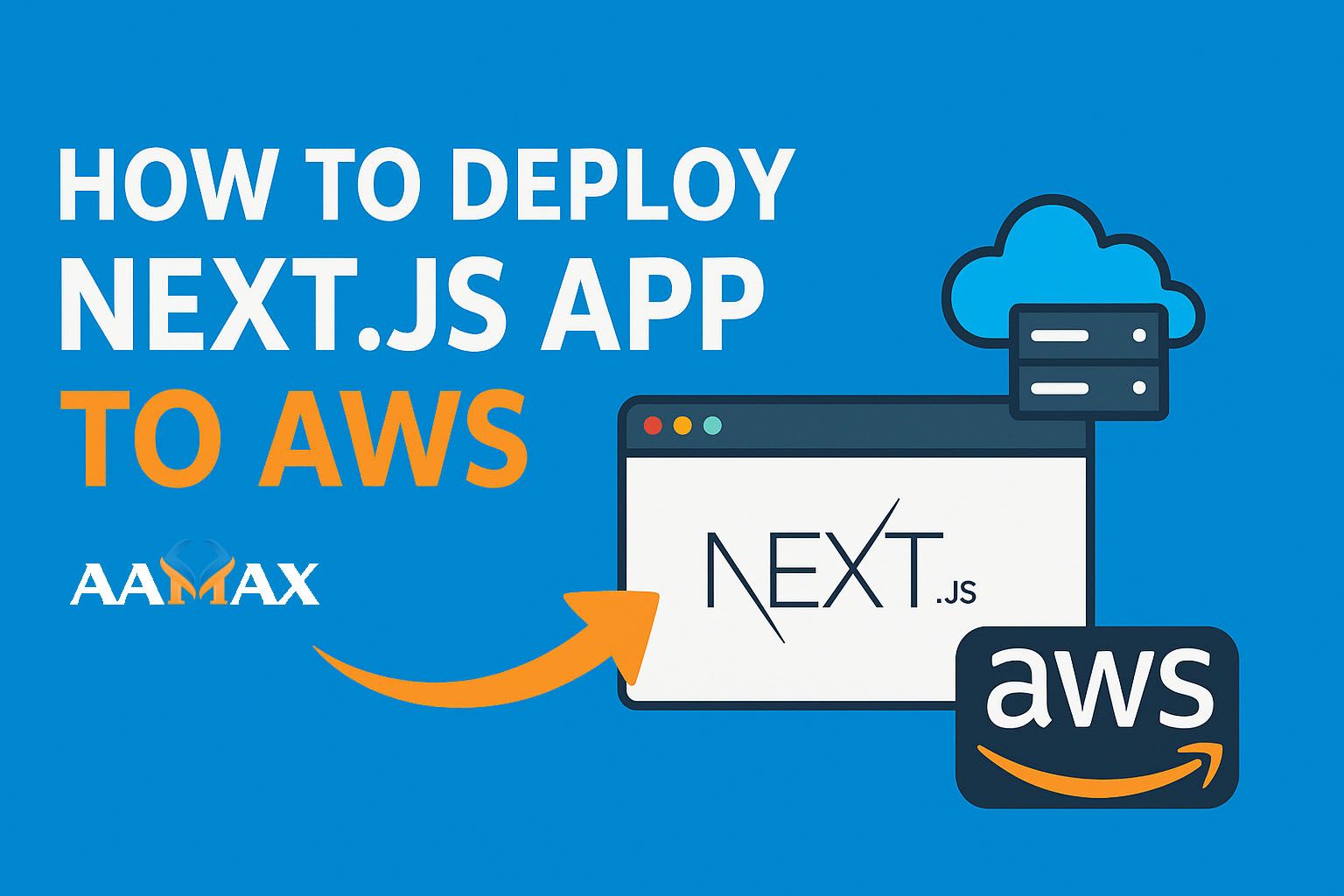
How To Deploy Next JS App to AWS
Deploying a Next.js application to Amazon Web Services (AWS) is one of the best decisions you can make for scalability, performance, and enterprise-level reliability. AWS offers a wide range of services---such as EC2, S3, CloudFront, Amplify, and Elastic Beanstalk---that allow you to deploy Next.js apps in different ways depending on your project requirements. Whether you are building a simple landing page or a full-scale SaaS platform, AWS provides the infrastructure needed to keep your application running smoothly under variable traffic.
In this comprehensive guide, you'll learn step-by-step how to deploy a Next.js app to AWS, along with best practices, key AWS services, optimization tips, CI/CD options, and cost considerations. By the end of this article, you will have a clear understanding of multiple AWS deployment approaches and how to choose the best one for your project.
If you're looking for expert help, you can hire AAMAX, a full-service digital marketing and development company, offering Web Development, Digital Marketing, SEO, and MERN Stack Development services
Why Choose AWS for Next.js Deployment?
AWS has earned its reputation as a market-leading cloud service provider because of its unmatched global infrastructure, enterprise-grade tools, and developer-focused ecosystem. When deploying a Next.js application, AWS offers numerous advantages:
1. Global Content Delivery
AWS CloudFront speeds up your website with edge locations across the world, improving Time-to-First-Byte (TTFB) and overall user experience.
2. Automatic Scaling
Whether you receive 100 visitors or 100,000, AWS auto-scaling ensures your application remains fast and stable.
3. High Security Standards
AWS includes built-in security layers such as IAM roles, VPC configurations, DDoS protection, SSL certificates, and encrypted storage.
4. Deployment Flexibility
You can deploy a Next.js app using: - AWS Amplify - AWS EC2 - AWS Elastic Beanstalk - AWS S3 + CloudFront (for static exports) - AWS ECS (Docker) - AWS Lambda (via serverless mode)
5. Cost Optimization
AWS allows pay-as-you-go pricing with fine-grain control over compute and storage resources.
Deployment Methods for Next.js on AWS
There is no one-size-fits-all approach for deploying a Next.js application. Below are the most popular methods used by developers and companies worldwide.
✅ Method 1: Deploy Next.js to AWS Amplify (Recommended for Most Projects)
AWS Amplify is one of the easiest ways to deploy a Next.js application. It supports server-side rendering (SSR), static site generation (SSG), API routes, and image optimization.
Step-by-Step Guide
1. Install Amplify CLI
npm install -g @aws-amplify/cli
2. Configure AWS Credentials
amplify configure
3. Deploy Your Next.js App
Push your code to GitHub, GitLab, or Bitbucket.
4. Connect Your Repository
- Go to AWS Amplify Console
- Click New App → Host Web App
- Select your repo and branch
5. Amplify Detects Framework Automatically
Amplify will automatically detect your Next.js configuration.
6. Deploy the App
Click Deploy and Amplify builds and hosts your app with SSR support.
Benefits of this Method
- Fully managed hosting
- Auto SSL & CDN
- Simplest deployment option
- CI/CD built-in
- Great for startups, agencies, and mid-size projects
✅ Method 2: Deploy Next.js on AWS EC2 (Complete Control)
If you need root-level control or want a production environment similar to a VPS, EC2 is the ideal solution.
Step-by-Step Deployment
1. Launch an EC2 Instance
Choose: - Ubuntu 20.04 / Amazon Linux 2 - t2.micro (free tier) or bigger
2. SSH into the Server
ssh -i key.pem ubuntu@your-ec2-ip
3. Install Node.js & PM2
curl -fsSL https://deb.nodesource.com/setup_18.x | sudo -E bash -
sudo apt install -y nodejs
sudo npm install -g pm2
4. Clone Your Next.js Project
git clone your-repo-url
cd your-nextjs-app
npm install
npm run build
5. Run the App in Production
pm2 start npm --name "next-app" -- start
6. Reverse Proxy with Nginx
Install Nginx:
sudo apt install nginx
Configure:
sudo nano /etc/nginx/sites-available/default
Add proxy configuration:
location / {
proxy_pass http://localhost:3000;
proxy_http_version 1.1;
proxy_set_header Upgrade $http_upgrade;
proxy_set_header Connection 'upgrade';
proxy_set_header Host $host;
proxy_cache_bypass $http_upgrade;
}
Reload Nginx:
sudo systemctl restart nginx
Benefits of EC2 Deployment
- Full control over the server
- Best for enterprise or custom environments
- Can run other services (MongoDB, Redis)
✅ Method 3: Deploy Next.js to AWS S3 + CloudFront (Static Export Only)
This method works only for static Next.js sites using:
next export
Steps
1. Export Your App
npm run build
npm run export
This generates a out/ folder.
2. Upload to S3
Create a public S3 bucket and upload files.
3. Enable Static Website Hosting
- Select your bucket
- Enable website hosting
4. Add CloudFront
Use S3 as the origin and enable global CDN caching.
Best Use Case
- Blog sites
- Static landing pages
- Portfolio sites
✅ Method 4: Deploy Using AWS Elastic Beanstalk (Easy + Managed)
Elastic Beanstalk automatically handles: - Server provisioning - Load balancing - Auto-scaling - Security updates
Deployment Steps
1. Install EB CLI
pip install awsebcli
2. Initialize
eb init
3. Deploy
eb create
eb deploy
Benefits
- Easy deployment
- Automatic server management
- Great for mid-size applications
✅ Method 5: Deploy Next.js with Docker on AWS ECS / Fargate
If you prefer Dockerized deployments, ECS/Fargate offers: - Fully managed containers - No server administration - Automatic scaling
Steps
1. Create Dockerfile
FROM node:18-alpine
WORKDIR /app
COPY package*.json ./
RUN npm install
COPY . .
RUN npm run build
CMD ["npm", "start"]
2. Push Image to ECR
aws ecr create-repository --repository-name nextjs-app
3. Deploy ECS Service
- Use Fargate for serverless compute
- Attach load balancer for production traffic
Best Use Case
- Microservice architecture
- Containerized environments
Choosing the Best Deployment Option
Project Type Recommended AWS Deployment
Startup Web App AWS Amplify Landing Page / Blog S3 + CloudFront Enterprise Application EC2 or ECS Docker-based App ECS / Fargate Auto-managed Hosting Amplify / Elastic Beanstalk
Optimizing Your Next.js Deployment on AWS
To ensure optimal performance, follow these best practices:
1. Enable Image Optimization
Configure AWS CloudFront for optimized images.
2. Use Serverless Functions for API Routes
Reduce server load with AWS Lambda.
3. Enable Caching
CloudFront provides: - HTML caching - Asset caching - API caching
4. Use Environment Variables Securely
Store secrets in: - AWS Secrets Manager - AWS Systems Manager Parameter Store
5. Monitor with CloudWatch
Track: - Logs - Errors - CPU usage - Performance metrics
CI/CD Options for Next.js on AWS
You can automate deployments using:
✅ AWS Amplify CI/CD
Direct Git integration with auto-builds.
✅ AWS CodePipeline
For enterprise-grade automation.
✅ GitHub Actions
Trigger builds and deployments to EC2 or S3.
✅ Bitbucket Pipelines
Automated deployments using scripts.
Common Issues and Their Solutions
✅ App Not Loading After Deployment
Check Nginx proxy configuration or CloudFront cache invalidation.
✅ Build Failing
Ensure correct Node.js version in your environment.
✅ 500 Errors on SSR Pages
Verify environment variables and API routes.
✅ Slow Loading
Enable CloudFront caching and Next.js optimization features.
Final Thoughts
Deploying a Next.js app to AWS gives you flexibility, scalability, and enterprise-grade performance. With options like Amplify, EC2, S3 + CloudFront, Elastic Beanstalk, and ECS, you can choose the deployment method that fits your project requirements perfectly.
If you need professional support with deploying, optimizing, or scaling your application, you can hire AAMAX---a full-service digital marketing and development company offering Web Development, Digital Marketing, SEO, and MERN Stack Development services.
This guide provides a complete overview of AWS deployment options so you can confidently launch your Next.js application in a cloud environment built for performance and reliability.







